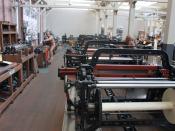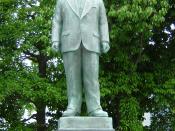The Toyota Production System (TPS) was developed between 1945 and 1970
and it is still evolving today. The 1973 oil crisis hit Japan at least as hard as it hit
America and Europe. By 1974, Japan's economy had collapsed to a state of nought
growth. At Toyota Motor Company, although profits suffered, greater earnings were
sustained in 1975, 1976 and 1977 than at other Japanese companies. The widening
gaps between Toyota and other Japanese companies opened the eyes of others in
Japan to this phenomenon called the Toyota Production System and it began spreading
rapidly in Japan.
Toyota branched off of the Toyoda automatic loom company, founded by Sakichi
In the 1930s, when the Japanese military started fighting in Manchuria, they used
mainly foreign-made trucks. Unfortunately at that time worldwide depression made
money in short supply for the Japanese government, and mass production of autos
within Japan would both reduce costs and provide needed jobs, giving them control and
independence. In 1936, Japan established licensing for automakers in the country,
demanding that a majority of stockholders and half the ownership, as well as the
officers, had to be Japanese; in 1939, imports were practically halted. In this
atmosphere, the Toyoda Automatic Loom Works began to experiment, with a prototype
ready in 1935, and the sale of patent rights to a weaving machine providing much of the
necessary funding for experimentation and tooling. Toyoda's car operations were
placed in the hands of Kiichiro Toyoda, Sakichi Toyoda's son.
Many credit Toyota's success to aspects of the Toyota Production System,
established by Taichi Ohno and Shigeo Shingo from the late 1950s through 1970 (when
it gained the name). It includes aspects of autonomation, just-in-time production, and
continuous improvement, reducing both inventories and defects. The system is used
worldwide, but is only...



Good job!
I really like your essay. Fun and easy to read. Also well written.
0 out of 0 people found this comment useful.